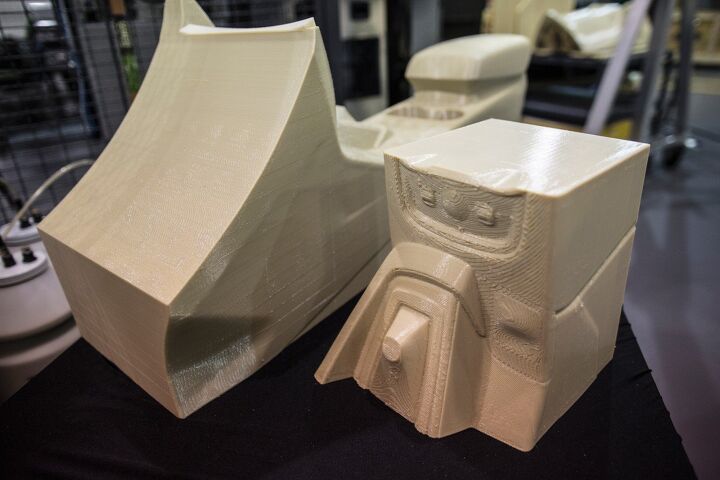Ford Moves a Step Closer to Mass 3D-printed Production Parts
Ford is trying its hand at a new way of manufacturing inexpensive and lightweight car parts: 3D printing.
While 3D printing has existed in the auto manufacturing scene for quite some time, it was largely used for prototypes and molds, not the actual product.
Ford is now looking to use the technology to produce a variety of customizable and low-volume parts.
Manufacturers have used this technology, in some capacity, for years. Local Motors designed and made the Strati, the first 3D printed electric car, and racing teams have used it for specialty parts.
Frank Stephenson, design chief at McLaren, told Forbes that the company’s product development period has shrunk from 36 months to 18 months, all thanks to 3D printing.
Manufacturers’ use of 3D printing used to be limited by the size of the parts able to be produced. In the case of the Blue Oval, that issue no longer exists.
Ford is using the massive Stratasys Infinite Build 3D printer to make parts that take up more than a little desk space. Large parts, such as a spoiler or long interior panel, is no problem for this room-sized mammoth.
For now, the destination for these parts remain low-volume performance cars and customizable options ordered by buyers. However, Ford’s Technical Leader for Additive Manufacturing Research, Ellen Lee, said in a media release that the new technology will eventually translate into large-scale 3D printed auto manufacturing.
[Images: Ford Motor Company]
More by Tyler Wooley
Latest Car Reviews
Read moreLatest Product Reviews
Read moreRecent Comments
- ToolGuy First picture: I realize that opinions vary on the height of modern trucks, but that entry door on the building is 80 inches tall and hits just below the headlights. Does anyone really believe this is reasonable?Second picture: I do not believe that is a good parking spot to be able to access the bed storage. More specifically, how do you plan to unload topsoil with the truck parked like that? Maybe you kids are taller than me.
- ToolGuy The other day I attempted to check the engine oil in one of my old embarrassing vehicles and I guess the red shop towel I used wasn't genuine Snap-on (lots of counterfeits floating around) plus my driveway isn't completely level and long story short, the engine seized 3 minutes later.No more used cars for me, and nothing but dealer service from here on in (the journalists were right).
- Doughboy Wow, Merc knocks it out of the park with their naming convention… again. /s
- Doughboy I’ve seen car bras before, but never car beards. ZZ Top would be proud.
- Bkojote Allright, actual person who knows trucks here, the article gets it a bit wrong.First off, the Maverick is not at all comparable to a Tacoma just because they're both Hybrids. Or lemme be blunt, the butch-est non-hybrid Maverick Tremor is suitable for 2/10 difficulty trails, a Trailhunter is for about 5/10 or maybe 6/10, just about the upper end of any stock vehicle you're buying from the factory. Aside from a Sasquatch Bronco or Rubicon Jeep Wrangler you're looking at something you're towing back if you want more capability (or perhaps something you /wish/ you were towing back.)Now, where the real world difference should play out is on the trail, where a lot of low speed crawling usually saps efficiency, especially when loaded to the gills. Real world MPG from a 4Runner is about 12-13mpg, So if this loaded-with-overlander-catalog Trailhunter is still pulling in the 20's - or even 18-19, that's a massive improvement.



































Comments
Join the conversation
Classic car parts: this is the obvious use for 3-D printing.
I just bought a small 3D printer to make parts for my Toyota and itt seems to work really well. Based on the filament you could make a good product